
Four years ago, our district was projected to perform at an “F” level based on its psychometric analysis at the time. Situated in a rural, agricultural region of Texas, we serve a diverse population of 500 students, many of whom are English language-learners (ELLs). About 90% of those students qualify for free or reduced lunch, and most of them—along with our teachers—deal with their own set of challenging life circumstances.
As with anything in life, these challenges only make us stronger and pushed us in the direction of a social-emotional learning (SEL) curriculum that would help build a framework of resiliency for our students, teachers, and administrators alike. After hearing Roberto Rivera speak about SEL at a TASA/TASB meeting leadership conference, we made few calls, tested out several SEL platforms and decided that 7 Mindsets would be the best fit for our district.
Achieving “B” status
Fast-forward four years and we continue to use our SEL curriculum to help build mental frameworks for resiliency, overcoming obstacles, and helping students believe in their own success. We’ve since achieved “B” status in the state (the rankings were put on hold during the pandemic), implemented the curriculum across the district and we also made it an important part of our interactions with the community.
Here are five ways our SEL curriculum helped us graduate from “F” to “B” status:
- Get positive buy-in from stakeholders. All teachers, staff and some board members participated in the initial training for our new SEL curriculum, which was then rolled out districtwide. Our very first training here was engaging; teachers bought in and saw the need. With that positive buy-in from our initial launch, that set us up for continued success with the SEL program’s implementation.
- Establish the building blocks. We initially began teaching SEL on “Mindset Mondays.” The time was blocked off on the school calendar and all students, teachers and classrooms focused on implementing the appropriate mindset for 30 minutes in homeroom or during a tutorial period. We started with the “We are Connected” mindset because, as a small community, our school is the heartbeat of that community.
- Expand SEL’s reach. We then worked through the remaining mindsets, changing them out on a weekly basis. We’re now working to integrate mindset lessons throughout the week in order to support a more holistic, SEL-focused culture on campus. Chilton ISD is also doing more “shout outs” to recognize teachers that exhibit the week’s mindset in their classes. We now want to start having more “intentional conversations” around specific mindsets on a regular basis on campus and we also integrate SEL-related activities into our district’s leadership meetings.
- Allows for reflection and promotes responsibility. I especially like how our SEL program supports reflection for both students and teachers alike. Our SEL curriculum gives us all the chance to reflect and build the type of culture and atmosphere that we want for our students. It also helps us understand that we are responsible for the culture and climate in our classrooms.
- Makes it easy for teachers to use. Our SEL curriculum is easy for teachers use and doesn’t require them to search for resources, plan out their curriculums and/or pool their resources to achieve a common goal. And while teachers do preview the lessons and develop thoughtful discussions around specific topics, the heavy lifting has already been done for them. Everything they need to implement is in the 7 Mindsets portal, where every video, activity and lesson is right at their fingertips.
Culture precedes achievement
As district leaders, we’re responsible for the culture and the climate in our classrooms. As we always say here at our district, “Culture precedes achievement.” By blending our SEL curriculum with a real desire to make a difference, our district has significantly exceeded expectations set forth by the state of Texas’ education department. We made that leap and performed the way we did because of the focus placed on SEL and the emphasis placed on providing students and teachers with the mental frameworks they needed to be resilient.
Brandon Hubbard is Superintendent at Chilton Independent School District in Chilton, Texas.
More from DA



